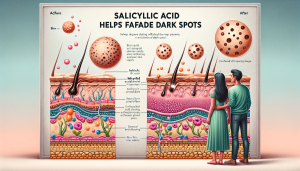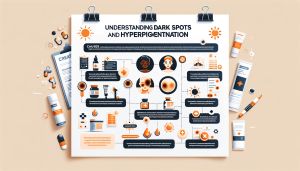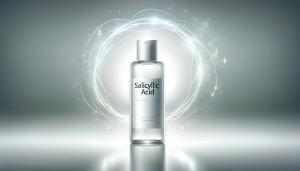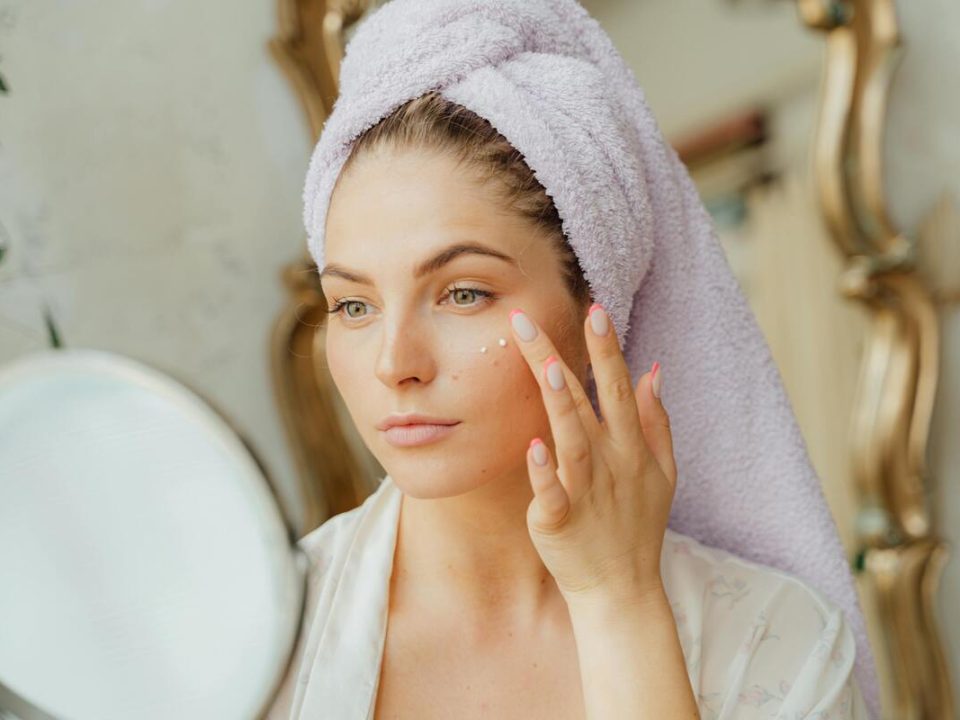
Does Salicylic Acid Remove Blackheads?
February 1, 2024
What Does Salicylic Acid Do To Your Skin?
March 6, 2024Struggling with stubborn dark spots? Salicylic acid might be your answer! This BHA superstar is known for its acne-fighting prowess, but can it also lighten those pesky post-blemish marks? Let’s delve into the science and effectiveness of salicylic acid for fading dark spots.

Salicylic Acid for Fading Dark Spots
Exfoliation and Cell Turnover: Unmasking Brighter Skin
Imagine your skin as a canvas, and dark spots as persistent paint splatters. Salicylic acid acts like a gentle remover, not erasing the spots directly, but promoting cell turnover underneath, revealing the fresh, unblemished canvas below. Here’s how:
- Shedding the Old: Salicylic acid, unlike AHAs that work on the skin’s surface, is oil-soluble, meaning it dives deep into your pores, dissolving the sticky bonds that hold dead skin cells together. This exfoliation process sheds the top layer of dull, pigmented cells, leaving behind smoother, brighter skin.
- Accelerating Renewal: Beyond removal, salicylic acid stimulates the production of new skin cells. Think of it as a gentle wake-up call for your skin, urging it to replace the lost cells with fresh, vibrant ones. This increased cell turnover pushes the pigmented dead cells further and further to the surface, where they eventually shed away, bringing the lighter layers below closer to the surface.
- Targeting Post-Blemish Marks: This exfoliating and cell-renewing duo is particularly effective for post-inflammatory hyperpigmentation (PIH), the dark spots left behind after acne breakouts. By eliminating the pigmented dead cells and encouraging new cell growth, salicylic acid helps fade the remnants of those pesky blemishes.
Remember: The process takes time and patience. Don’t expect overnight miracles! Consistent use of salicylic acid, along with proper sun protection, can gradually unveil a brighter, more even complexion.
Melanin Suppression: A Potential Fade-Out Mechanism
Melanin, the pigment that gives your skin its color, can sometimes become overproduced, leading to unwanted dark spots. While the research on salicylic acid’s direct impact on melanin production is still ongoing, some studies suggest it might have the potential to influence this process:
- Tyrosinase Inhibition: Tyrosinase is an enzyme that plays a key role in melanin production. Certain types of salicylic acid may potentially inhibit the activity of this enzyme, leading to a decrease in melanin synthesis.
- Anti-Inflammatory Properties: Inflammation can trigger melanin production in the skin. Salicylic acid’s anti-inflammatory properties can help calm irritated skin, potentially reducing the overproduction of melanin and, consequently, the appearance of dark spots.
- Indirect Impact: By exfoliating and promoting cell turnover, salicylic acid can remove melanin-laden dead cells from the surface, creating the illusion of lighter skin and reducing the overall darkness of your spots.
Clinical Evidence: A Mixed Bag
Research on salicylic acid’s melanin-suppressing effects is ongoing, with promising findings but also limitations:
- Studies with Positive Results:
- A 2018 study found that a combination of salicylic acid and niacinamide effectively reduced hyperpigmentation caused by melasma.
- A 2019 study showed that salicylic acid combined with glycolic acid improved the appearance of post-inflammatory hyperpigmentation (PIH).
- Limitations and Inconclusive Findings:
- Research often focuses on combinations of ingredients, making it difficult to isolate the specific impact of salicylic acid.
- Studies may have small sample sizes or methodological limitations, requiring further investigation.
- Individual responses to salicylic acid can vary significantly, highlighting the need for personalized approaches.
The Takeaway:
While evidence suggests salicylic acid may have some melanin-modulating potential, its effectiveness in fading dark spots requires further research. It’s likely most beneficial when combined with other brightening ingredients and used as part of a comprehensive skincare routine with sun protection.
Important Notes:
- Don’t expect overnight results: Fading dark spots is a gradual process. Be patient and consistent with your skincare regimen.
- Listen to your skin: Salicylic acid can be irritating, especially for sensitive skin. Start with low concentrations and patch test before applying it to a larger area.
- Seek professional advice: If you have concerns about dark spots or are unsure about appropriate treatments, consult a dermatologist for personalized recommendations.
It’s important to note: Melanin suppression research on salicylic acid is still evolving, and its effectiveness in this area can vary depending on individual skin types and the specific type of hyperpigmentation. Consulting a dermatologist for personalized advice is always recommended.
In essence, salicylic acid tackles dark spots from both angles: promoting cell turnover to reveal brighter skin underneath and potentially influencing melanin production for a gradual lightening effect. Remember, consistency and patience are key! With proper care and the right product choice, you can gradually fade those stubborn dark spots and embrace a more radiant complexion.

Salicylic Acid: The BHA Powerhouse
What is Salicylic Acid?
Salicylic acid is a multifaceted molecule best known for its role in skincare. Chemically, it belongs to the beta hydroxy acid (BHA) family, which differs from the more familiar alpha hydroxy acids (AHAs) like glycolic and lactic acid in a few key ways. Let’s delve into its structure and unique properties:
- Molecular Structure: Imagine a benzene ring (six carbon atoms bonded in a hexagonal shape) adorned with a hydroxyl group (-OH) and a carboxyl group (-COOH). These functional groups grant salicylic acid its distinctive capabilities.
- Oil Solubility: Unlike AHAs, which are water-soluble, salicylic acid boasts oil solubility. This translates to a deeper penetration into pores, where it can directly tackle excess sebum (oil) and prevent clogging, making it a hero for oily and acne-prone skin.
- Keratolytic Power: Salicylic acid acts as a keratolytic agent, meaning it loosens the bonds between dead skin cells. This gentle exfoliation process promotes cell turnover, revealing brighter, fresher skin underneath. This property also extends into hair follicles, making it useful for treating keratosis pilaris (rough bumps on arms and legs).
- Anti-inflammatory Properties: Beyond exfoliation, salicylic acid possesses anti-inflammatory properties. This helps soothe redness and irritation commonly associated with acne and other skin conditions.
Mechanism of Action:
Now, let’s take a peek under the hood and see how salicylic acid works its magic on the skin:
- Exfoliation: As mentioned above, salicylic acid weakens the bonds between dead skin cells, encouraging their natural shedding. This unclogs pores, prevents breakouts, and promotes a smoother, more even complexion.
- Pore Penetration: With its oil-soluble nature, salicylic acid dives deep into pores, dissolving excess sebum and debris. This helps keep pores clear and minimizes the chance of clogged pores and blackheads.
- Keratin Regulation: Salicylic acid also regulates the production of keratin, the protein that forms the main component of the skin’s outer layer. By controlling keratin production, it prevents the formation of rough patches and promotes a healthy, glowing skin texture.
- Potential Melanin Modulation: While research is ongoing, some studies suggest that salicylic acid might influence melanin production to a mild degree. This could contribute to the gradual lightening of dark spots caused by acne or inflammation.
By understanding these unique properties and mechanisms of action, we can appreciate the multifaceted potential of salicylic acid in addressing various skin concerns, including its contribution to fading dark spots, which we will explore further in the upcoming sections.

Understanding Dark Spots and Hyperpigmentation
Causes of Dark Spots
Dark spots, also known as hyperpigmentation, can cast a shadow on your confidence. But uncovering the cause behind these patches is the first step to diminishing their power. Let’s explore the major culprits responsible for the formation of dark spots:
- Sun Exposure: The sun’s ultraviolet (UV) rays are notorious for triggering hyperpigmentation. When UV rays interact with skin cells, they stimulate melanin production, the pigment responsible for skin color. This increased melanin can manifest as dark spots, especially on areas exposed to sunlight like the face, neck, and hands.
- Acne: Breakouts aren’t just painful in the moment; they can leave lingering marks in the form of post-inflammatory hyperpigmentation (PIH). When acne heals, inflammation can trigger melanin overproduction, leading to dark spots that appear reddish-brown or brown. PIH is more common in individuals with darker skin tones.
- Inflammation: Skin conditions like eczema, psoriasis, and allergic reactions can also lead to dark spots. Similar to acne, inflammation caused by these conditions can disrupt melanin production, resulting in hyperpigmentation patches.
- Hormonal Changes: Fluctuations in hormone levels, particularly estrogen and progesterone, can trigger melanin production and hyperpigmentation. This is why many women experience dark spots during pregnancy, around their menstrual cycle, or while taking hormonal medications.
- Certain Medications: Some medications, such as birth control pills, anti-seizure drugs, and antibiotics, can list photosensitivity as a side effect. This means they can make your skin more sensitive to UV rays, increasing the risk of sun-induced hyperpigmentation.
- Medical Conditions: In rare cases, underlying medical conditions like Addison’s disease or hemochromatosis can affect melanin production and lead to widespread hyperpigmentation.
Understanding the root cause of your dark spots is crucial for choosing the right treatment approach. Consult with a dermatologist if you’re concerned about persistent hyperpigmentation or have underlying medical conditions.
Unveiling the Masks: Exploring Different Types of Hyperpigmentation
Not all dark spots are created equal! Hyperpigmentation comes in various forms, each with its distinct characteristics:
- Melasma: Melasma manifests as irregular brown patches, often appearing symmetrically on the face, especially the cheeks, forehead, and upper lip. Hormonal changes like pregnancy and sun exposure are the primary triggers for melasma.
- Post-inflammatory Hyperpigmentation (PIH): As mentioned earlier, PIH occurs after skin inflammation, leaving behind reddish-brown or brown marks. Acne, burns, and even insect bites can contribute to PIH formation.
- Freckles: These charming sun-kissed spots are a type of hyperpigmentation caused by sun exposure and genetic predisposition. While not necessarily considered a concern, some individuals may seek to lighten or minimize the appearance of freckles.
- Age Spots (Solar Lentigines): These flat, brown spots typically appear on sun-exposed areas like the hands, face, and arms. As the name suggests, age spots are more common in older individuals due to cumulative sun exposure.
- Café-au-Lait Macules: These large, light brown patches are often present at birth or appear in early childhood. Café-au-lait macules are usually not a cause for concern unless they increase in number or size significantly.
Remember, hyperpigmentation is a common skin concern, and understanding its various forms empowers you to make informed choices about managing and minimizing its appearance. By addressing the underlying causes and implementing appropriate treatment strategies, you can gradually unveil a brighter, more even complexion.

Factors to Consider
Concentration:
- Low concentrations (1-2%): Often found in cleansers and toners, these are gentle, good for daily use, and ideal for sensitive skin. They primarily focus on exfoliation and preventing breakouts, and their effect on dark spots might be subtle.
- Moderate concentrations (2-5%): Common in serums and targeted treatments, these offer a more potent approach to exfoliation and melanin suppression, leading to faster fading of dark spots. However, they can be more irritating, especially for sensitive skin.
- High concentrations (up to 10%): Primarily used in professional peels and masks, these can be significantly irritating and require careful administration by a dermatologist.
Formulation:
- Leave-on products (serums, masks): Offer prolonged contact with the skin, maximizing their effectiveness but also increasing the risk of irritation.
- Rinse-off products (cleansers, washes): Provide shorter contact time and are generally gentler, but their impact on dark spots might be less pronounced.
- Oil-based vs. water-based: Oil-based formulas can penetrate deeper into pores, potentially enhancing effectiveness, while water-based options tend to be milder and suitable for sensitive skin.
Skin Type and Sensitivity:
Individual skin types react differently to salicylic acid. Here’s what to consider:
- Oily skin: Can tolerate higher concentrations due to increased sebum production and thicker stratum corneum, but watch for dryness and irritation.
- Dry skin: Opt for lower concentrations and milder formulations, prioritize hydration, and be extra cautious of potential peeling and over-exfoliation.
- Sensitive skin: Start with the lowest concentration possible, choose gentle formats like toners or mists, and patch test before applying all over the face.
- Pregnant or breastfeeding: Consult your doctor before using salicylic acid, as its safety during these periods is still under investigation.
Patch testing is crucial for everyone, regardless of skin type. Apply a small amount of the product on a non-conspicuous area and monitor for any redness, itching, or burning within 24 hours.
Sun Protection and Synergistic Combinations: Boosting BHA Benefits
Sun protection is non-negotiable when using salicylic acid for dark spots. Exfoliation makes the skin more susceptible to sun damage, which can worsen hyperpigmentation. Always apply a broad-spectrum SPF 30 or higher daily, even on cloudy days.
Salicylic acid can be effectively combined with other ingredients for an enhanced approach to dark spots:
- Niacinamide: This calming and brightening ingredient helps suppress melanin production and even skin tone, complementing salicylic acid’s exfoliating action.
- Vitamin C: A powerful antioxidant, vitamin C protects against free radical damage and stimulates collagen production, leading to brighter, healthier skin.
- AHAs: Alpha hydroxy acids like glycolic acid can further enhance exfoliation and cell turnover, but be cautious of over-exfoliation and irritation when combining them with BHA.
Remember, consistency is key. While salicylic acid might not erase dark spots overnight, its gradual lightening effect can be significant with regular use and proper care. By understanding your skin and choosing the right concentration, formulation, and complementary ingredients, you can unlock the full potential of salicylic acid for a brighter, more even complexion.

Alternatives and Complementary Treatments
Exploring Other Options for Faded Spots
Alpha Hydroxy Acids (AHAs): These chemical exfoliants work wonders on the skin’s surface, dissolving dead cells and promoting cell turnover. Popular AHAs include:
- Glycolic Acid: The strongest and most popular AHA, derived from sugar cane. It’s great for fading dark spots, promoting collagen production, and smoothing wrinkles.
- Glycolic Acid molecule
- Lactic Acid: A gentler AHA derived from milk, ideal for sensitive skin. It exfoliates, brightens, and hydrates, making it a good choice for tackling post-inflammatory hyperpigmentation.
- Lactic Acid molecule
- Mandelic Acid: Another gentle AHA suitable for sensitive skin, derived from bitter almonds. It’s adept at fading dark spots, evening skin tone, and minimizing fine lines.
- Mandelic Acid molecule
Topical Brightening Ingredients:
These go beyond simple exfoliation and target melanin production itself. Some noteworthy options include:
- Hydroquinone: Considered the gold standard for lightening dark spots, this prescription medication effectively inhibits melanin production. However, it can be irritating and has potential side effects, so consult a dermatologist before using it.
- Hydroquinone molecule
- Kojic Acid: A naturally occurring acid derived from fungi, kojic acid also blocks tyrosinase, the enzyme responsible for melanin production. It’s gentler than hydroquinone but may not be as effective for darker skin tones.
- Kojic Acid molecule
- Niacinamide: This all-rounder not only brightens skin but also improves texture, minimizes pores, and strengthens the skin barrier. It’s well-tolerated and can be safely combined with other ingredients.
- Niacinamide molecule
Professional Treatments:
For stubborn hyperpigmentation that resists topical treatments, in-office procedures can offer dramatic results:
- Laser Therapy: Targeted laser beams break down melanin pigment in dark spots, effectively lightening them. Different types of lasers cater to various skin tones and pigmentation depths.
- Laser therapy for skin pigmentation
- Chemical Peels: Formulated acids like glycolic or TCA peel away the top layer of skin, revealing brighter, newer skin underneath. The depth and strength of the peel depend on your skin type and pigmentation needs.
- Chemical peel for skin pigmentation
- Microneedling: Tiny needles create micro-injuries in the skin, stimulating collagen production and triggering skin healing. This process can lighten dark spots and improve overall skin texture.
- Microneedling for skin pigmentation
Choosing the Right Approach:
The best option for you depends on several factors:
- Severity of Hyperpigmentation: Mild dark spots might respond well to salicylic acid or AHAs, while deeper pigmentation may require professional treatments.
- Skin Type and Sensitivity: Choose gentle ingredients for sensitive skin and consult a dermatologist for stronger options.
- Overall Skin Goals: Consider additional concerns like wrinkles, acne, or dryness when choosing your brightening strategy.
Remember, consistency and sun protection are key to success. No matter which approach you choose, be patient and diligent, and your radiant complexion awaits!
Additional Tips:
- Before starting any new skincare routine, always perform a patch test on a small area of your skin.
- Consult a dermatologist for personalized advice and treatment recommendations.
- Never pick or scratch at dark spots, as this can worsen the hyperpigmentation.
- Maintain a healthy lifestyle with proper hydration, sun protection, and a balanced diet for optimal skin health.
I hope this expanded information helps you navigate the exciting world of skin brightening and find the perfect solution for your dark spots!
Conclusion
While salicylic acid isn’t a magic eraser for dark spots, it can be a valuable tool in your fading arsenal. Its exfoliating and potentially melanin-suppressing properties offer a gradual lightening effect, especially for dark spots associated with acne. Remember, consistency, sun protection, and proper product choice are key. For deep-seated hyperpigmentation, consider consulting a dermatologist for personalized recommendations and potential combination therapies. Embrace your journey towards a brighter, more even complexion, one exfoliating step at a time!









